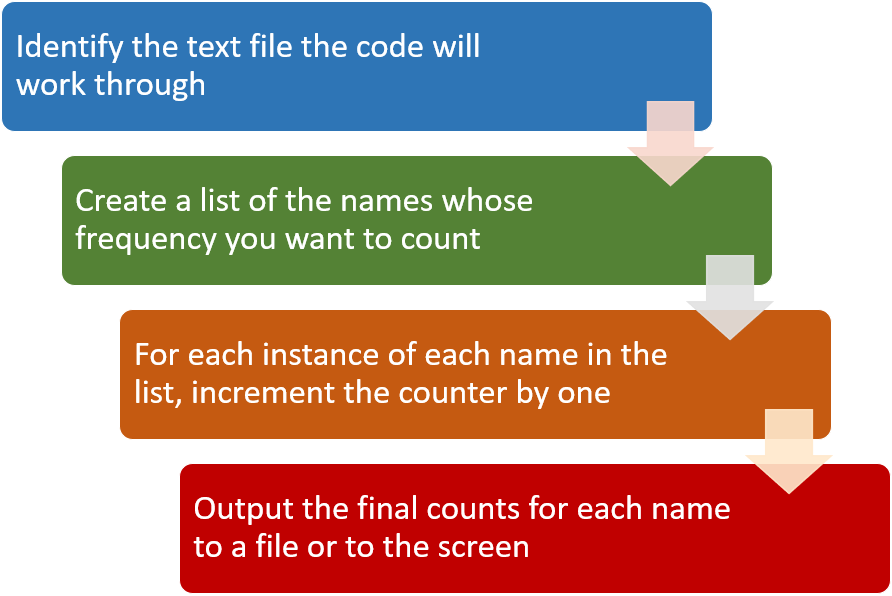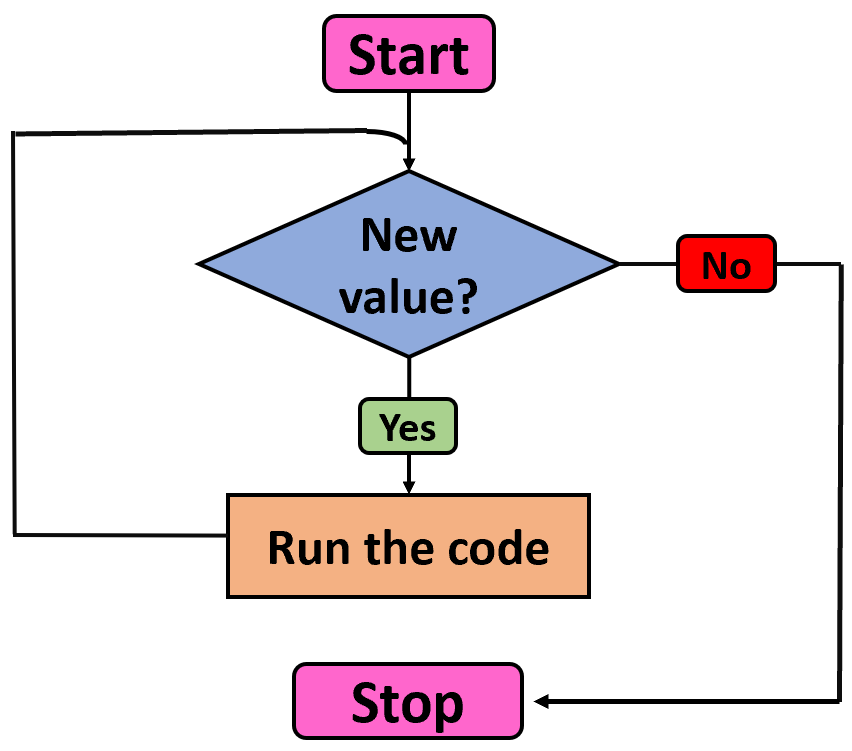Pseudocode
Regardless of programming language, pseudocode is a useful tool to break coding problems down. Pseudocode helps you list each step of a planned process so your steps are in a logical order before you code.
Pseudocode is also a good way to explain your needs to software developers or to run your ideas past people who may not be programmers.
Pseudocode example
Suppose we are fans of the Lord of the Rings novels, but we wonder how much the female character of Galadriel featured in the story compared to the male characters Frodo, Gandalf, Aragorn, Legolas and Boromir. We could flick through, say, The Fellowship of the Ring to check (which would be painfully slow), or we could run a short piece of code to count the number of times each character’s name is mentioned throughout the story. We could document those steps in pseudocode before writing any code to be sure we have covered all the things we will need to do.

Notes
- The text only version of The Fellowship of the Ring is the file the code will process.
- The characters’ names, Galadriel, Frodo, Gandalf, Aragorn, Legolas and Boromir are the values the program will look for and count.
- A
.txtfile is important for this kind of activity, as all the “smart” formatting (i.e. curly quote marks, hyphens converted toemandendashes) that appear within a.docor.docxfile is stripped out when saving a.docor.docxfile as a.txtfile. - We could re-use the code to run a similar operation on The Two Towers and The Return Of The King, or we could adapt the code even further for any name or word frequency question we want to automate.
Spoiler alert - Galadriel gets only 35 mentions by name compared to Frodo’s 944.
Loops
The code that will be used to do this job is an example of a loop. Loops allow us to execute the same command over and over again until a certain pre-set condition has been met. In this case, the condition is to have counted all the appearances of each name on a designated list.

In the example above, the program will search all the way through the text of The Fellowship of the Ring, adding up all the appearances of the first value in the list (Galadriel). Then it will go through the text again to do the count for the second value (Frodo). The same process will then be done for all the other characters respectively, and then the program will report its findings for each value. It will then stop running because the list of names has been exhausted, i.e. the condition has been met.
The name values can also be called variables, because the value will vary each time the loop runs through the text. Variables are an important part of abstraction.
The same piece of code could be re-used for any word counting exercise by changing the list variables and the input source. That would be another example of abstraction.
Practice 1. Creating backup copies of files
In a folder, we have 250 image files for which we want to create backup copies before we process the images for archiving. Manually creating 250 copies of files seems like a very boring thing to do, so we are going to automate the workflow to create the backup copies.
Write some pseudocode of how you might automate this process.
Practice 2a. Tidying up
We have a large folder of files left over from a project that is now finished. The files are all sitting in the one folder which makes it hard to navigate. We want to archive the project and its files, but in the process, we want to create folders by file type, e.g., .pdf, .jpg, .doc, so that anyone wanting to access those particular file types can do so easily. We also want to delete files that have no file extensions. New folders will need to be created and the different files moved into them by file type.
Write some pseudocode of how you might automate this process.
Practice 2b. Tidying up more carefully
In the process of doing the above, we actually made a few blunders. We accidentally deleted some files we should have kept either because they were mislabelled or they were missing a file extension. Because this automation is a complex operation that cannot be undone, we want to make sure we don’t make those kinds of mistakes again.
One way to do that is to check we have coded the workflow correctly before we finally execute the automation. Therefore we could introduce a step that mimics what would happen if we executed the script on the files, perhaps by printing the filenames we want to move or delete to the screen (or to a file) rather than actually deleting or moving them. That way we can check we are working on the correct files and only execute the final move workflow once we are sure we have everything right.
Write some pseudocode for that step of the process.
Practice 3. Managing incoming data
Suppose you have a number of acoustic listening devices set up in the bush. Every day, you receive an email from each device with an attached data file recording that day’s activity. In order to analyse the data from the devices, all the separate daily data files need to be combined weekly into a single file. It is important that each device ID is listed within a column in the combined data file to identify all the different locations.
In order to analyse the data over time, you need to append the weekly file digest to the existing, now very large, main data file. Before adding anything new, and in order to safeguard the integrity of the data, you need to create a backup of that main data file and send a copy of that backup file to your cloud storage account for safekeeping. Once the new data has been appended, you need to rename the new main data file with today’s date as part of the file name, and run software against the file to ensure the integrity of the data, e.g., to check that no data is missing (which might indicate a malfunctioning device).
Write some pseudocode of how you might automate this process.
Some potential solutions to these practice coding exercises can be found on the Solutions page.
Learning to program
This lesson should help you prepare to learn to code by understanding the process that coders use to break complex problems down into programmable parts.
Links to sites that teach coding and other resources on computational thinking are listed in the Resources section.
For later
Suppose you write that file movement script and it works a treat.
Why not get it to run every month to tidy up folders that invariably become messy over time, e.g., your computer’s Downloads folder?
Or, suppose you use a file naming convention that starts with YYYY-MM-DD. Why not run a script annually to sort and organise your documents by year?